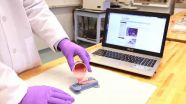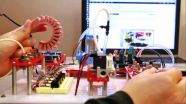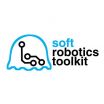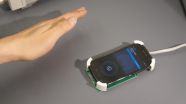(Press-News.org) A new resource unveiled today by researchers from several Harvard University labs in collaboration with Trinity College Dublin provides both experienced and aspiring researchers with the intellectual raw materials needed to design, build, and operate robots made from soft, flexible materials.
With the advent of low-cost 3D printing, laser cutters, and other advances in manufacturing technology, soft robotics is emerging as an increasingly important field. Using principles drawn from conventional rigid robot design, but working with pliable materials, engineers are pioneering the use of soft robotics for assisting in a wide variety of tasks such as physical therapy, minimally invasive surgery, and search-and-rescue operations in dangerous environments.
The Soft Robotics Toolkit is an online treasure trove of downloadable, open-source plans, how-to videos, and case studies to assist users in the design, fabrication, modeling, characterization, and control of soft robotic devices. It will provide researchers with a level of detail not typically found in academic research papers, including 3D models, bills of materials, raw experimental data, multimedia step-by-step tutorials, and case studies of various soft robot designs.
"The goal of the toolkit is to advance the field of soft robotics by allowing designers and researchers to build upon each other's work," says Conor Walsh, Assistant Professor of Mechanical and Biomedical Engineering at the Harvard School of Engineering and Applied Sciences (SEAS) and a Core Faculty Member at the Wyss Institute for Biologically Inspired Engineering at Harvard University.
By creating a common resource for sharing design approaches, prototyping and fabrication techniques, and technical knowledge, the toolkit's developers hope to stimulate the creation of new kinds of soft devices, tools, and methods.
According to Walsh, who teaches a popular course in medical device design at SEAS and is founder of the Harvard Biodesign Lab, soft robotics is especially well suited to shared design tools because many of the required components, such as regulators, valves, and microcontrollers, are largely interchangeable between systems.
Dónal Holland, a visiting lecturer in engineering sciences at SEAS and graduate student at Trinity College Dublin, is one of the lead developers of the toolkit and is especially interested in the toolkit's potential as an educational resource.
"One thing we've seen in design courses is that students greatly benefit from access to more experienced peers—say, postdocs in a research lab—who can guide them through their work," Holland says. "But scaling that up is difficult; you quickly run out of time and people. The toolkit is designed to capture the expertise and make it easily accessible to students."
Just as open-source software has spurred far-flung innovation in computing, "open design" hardware platforms—coupled with advances in computer-aided engineering and more accessible prototyping capabilities—have the potential to foster remote collaboration on common mechanical engineering projects, unleashing crowdsourced creativity in robotics and other fields.
"Open design can have as disruptive an influence on technology development in this century as open source did in the last," says Gareth J. Bennett, assistant professor of mechanical and manufacturing engineering at Trinity College Dublin and a coauthor of a paper in Soft Robotics that describes the toolkit development. Additional coauthors are Evelyn J. Park '13, a SEAS research fellow in materials science and engineering, and Panagiotis Polygerinos, a postdoctoral fellow in the Harvard Biodesign Lab at SEAS and the Wyss Institute.
INFORMATION:
Much of the material included in the toolkit sprang from the labs of Robert J. Wood, Charles River Professor of Engineering and Applied Sciences at SEAS, and chemist George M. Whitesides, Woodford L. and Ann A. Flowers University Professor, two researchers whose work has helped establish Harvard as a leader in soft robotics. Wood and Whitesides are also core faculty members of the Wyss Institute.
Soft robotics 'toolkit' features everything a robot-maker needs
Online resource is designed to foster innovation and learning
2014-09-19
ELSE PRESS RELEASES FROM THIS DATE:
Fingertip sensor gives robot unprecedented dexterity
2014-09-19
CAMBRIDGE, Mass-- Researchers at MIT and Northeastern University have equipped a robot with a novel tactile sensor that lets it grasp a USB cable draped freely over a hook and insert it into a USB port.
The sensor is an adaptation of a technology called GelSight, which was developed by the lab of Edward Adelson, the John and Dorothy Wilson Professor of Vision Science at MIT, and first described in 2009. The new sensor isn't as sensitive as the original GelSight sensor, which could resolve details on the micrometer scale. But it's smaller — small enough to fit on a robot's ...
Mayo researchers reveal pathway that contributes to Alzheimer's disease
2014-09-19
JACKSONVILLE, Fla. — Researchers at Jacksonville's campus of Mayo Clinic have discovered a defect in a key cell-signaling pathway they say contributes to both overproduction of toxic protein in the brains of Alzheimer's disease patients as well as loss of communication between neurons — both significant contributors to this type of dementia.
Their study, in the online issue of Neuron, offers the potential that targeting this specific defect with drugs "may rejuvenate or rescue this pathway," says the study's lead investigator, Guojun Bu, Ph.D., a neuroscientist at Mayo ...
A refined approach to proteins at low resolution
2014-09-19
Membrane proteins and large protein complexes are notoriously difficult to study with X-ray crystallography, not least because they are often very difficult, if not impossible, to crystallize, but also because their very nature means they are highly flexible. The result is that when a structure can be obtained it is often of low resolution, ambiguous and reveals a mosaic-like spread of protein domains that sometimes create more puzzles than they solve. [Schröder, Levitt & Brunger. (2014), Acta Cryst. D70, 2241-2255; doi: 10.1107/S1399004714016496 ]
Now, Gunnar Schröder ...
Reflected smartphone transmissions enable gesture control
2014-09-19
With almost all of the U.S. population armed with cellphones – and close to 80 percent carrying a smartphone – mobile phones have become second-nature for most people.
What's coming next, say University of Washington researchers, is the ability to interact with our devices not just with touchscreens, but through gestures in the space around the phone. Some smartphones are starting to incorporate 3-D gesture sensing based on cameras, for example, but cameras consume significant battery power and require a clear view of the user's hands.
UW engineers have developed a ...
Patients with advanced, incurable cancer denied palliative care
2014-09-19
Many patients with advanced, incurable cancer do not receive any palliative care, reveals new research to be presented later this month at the ESMO 2014 Congress in Madrid, Spain, 26-30 September. The findings are astonishing as they come at the same time as 15 new oncology centres in Europe, Canada, South America and Africa are being awarded the prestigious title of 'ESMO Designated Centre of Integrated Oncology and Palliative Care.'
SR I Dr Alexandru Grigorescu, medical oncology consultant at the Institute of Oncology Bucharest, Romania, member of the ESMO Palliative ...
Graphene sensor tracks down cancer biomarkers
2014-09-19
An ultrasensitive biosensor made from the wonder material graphene has been used to detect molecules that indicate an increased risk of developing cancer.
The biosensor has been shown to be more than five times more sensitive than bioassay tests currently in use, and was able to provide results in a matter of minutes, opening up the possibility of a rapid, point-of-care diagnostic tool for patients.
The biosensor has been presented today, 19 September, in IOP Publishing's journal 2D Materials.
To develop a viable bionsensor, the researchers, from the University of ...
Simple test can help detect Alzheimer's before dementia signs show: York U study
2014-09-19
TORONTO, Sept. 19, 2014 — York University researchers say a simple test that combines thinking and movement can help to detect heightened risk for developing Alzheimer's disease in a person, even before there are any telltale behavioural signs of dementia.
Faculty of Health Professor Lauren Sergio and PhD candidate Kara Hawkins who led the study asked the participants to complete four increasingly demanding visual-spatial and cognitive-motor tasks, on dual screen laptop computers. The test aimed at detecting the tendency for Alzheimer's in those who were having cognitive ...
Shrink-wrapping spacesuits
2014-09-19
For future astronauts, the process of suiting up may go something like this: Instead of climbing into a conventional, bulky, gas-pressurized suit, an astronaut may don a lightweight, stretchy garment, lined with tiny, musclelike coils. She would then plug in to a spacecraft's power supply, triggering the coils to contract and essentially shrink-wrap the garment around her body.
The skintight, pressurized suit would not only support the astronaut, but would give her much more freedom to move during planetary exploration. To take the suit off, she would only have to apply ...
New hadrosaur noses into spotlight
2014-09-19
Call it the Jimmy Durante of dinosaurs – a newly discovered hadrosaur with a truly distinctive nasal profile. The new dinosaur, named Rhinorex condrupus by paleontologists from North Carolina State University and Brigham Young University, lived in what is now Utah approximately 75 million years ago during the Late Cretaceous period.
Rhinorex, which translates roughly into "King Nose," was a plant-eater and a close relative of other Cretaceous hadrosaurs like Parasaurolophus and Edmontosaurus. Hadrosaurs are usually identified by bony crests that extended from the skull, ...
Researchers discover new gene responsible for traits involved in diabetes
2014-09-19
A collaborative research team led by Medical College of Wisconsin (MCW) scientists has identified a new gene associated with fasting glucose and insulin levels in rats, mice and in humans. The findings are published in the September issue of Genetics.
Leah Solberg Woods, Ph.D., associate professor of pediatrics at MCW and a researcher in the Children's Hospital of Wisconsin Research Institute, led the study and is the corresponding author of the paper.
The authors of the paper identified a gene called Tpcn2 in which a variant was associated with fasting glucose levels ...
LAST 30 PRESS RELEASES:
Making lighter work of calculating fluid and heat flow
Normalizing blood sugar can halve heart attack risk
Lowering blood sugar cuts heart attack risk in people with prediabetes
Study links genetic variants to risk of blinding eye disease in premature infants
Non-opioid ‘pain sponge’ therapy halts cartilage degeneration and relieves chronic pain
AI can pick up cultural values by mimicking how kids learn
China’s ecological redlines offer fast track to 30 x 30 global conservation goal
Invisible indoor threats: emerging household contaminants and their growing risks to human health
Adding antibody treatment to chemo boosts outcomes for children with rare cancer
Germline pathogenic variants among women without a history of breast cancer
Tanning beds triple melanoma risk, potentially causing broad DNA damage
Unique bond identified as key to viral infection speed
Indoor tanning makes youthful skin much older on a genetic level
Mouse model sheds new light on the causes and potential solutions to human GI problems linked to muscular dystrophy
The Journal of Nuclear Medicine ahead-of-print tip sheet: December 12, 2025
Smarter tools for peering into the microscopic world
Applications open for funding to conduct research in the Kinsey Institute archives
Global measure underestimates the severity of food insecurity
Child survivors of critical illness are missing out on timely follow up care
Risk-based vs annual breast cancer screening / the WISDOM randomized clinical trial
University of Toronto launches Electric Vehicle Innovation Ontario to accelerate advanced EV technologies and build Canada’s innovation advantage
Early relapse predicts poor outcomes in aggressive blood cancer
American College of Lifestyle Medicine applauds two CMS models aligned with lifestyle medicine practice and reimbursement
Clinical trial finds cannabis use not a barrier to quitting nicotine vaping
Supplemental nutrition assistance program policies and food insecurity
Switching immune cells to “night mode” could limit damage after a heart attack, study suggests
URI-based Global RIghts Project report spotlights continued troubling trends in worldwide inhumane treatment
Neutrophils are less aggressive at night, explaining why nighttime heart attacks cause less damage than daytime events
Menopausal hormone therapy may not pose breast cancer risk for women with BRCA mutations
Mobile health tool may improve quality of life for adolescent and young adult breast cancer survivors
[Press-News.org] Soft robotics 'toolkit' features everything a robot-maker needsOnline resource is designed to foster innovation and learning






